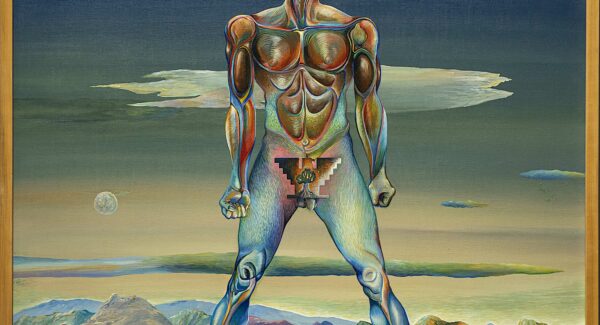
Roberto Ríos, “Mestizo” (Mixed Race; detail of torso), 1976, acrylic on canvas, courtesy of the artist. Photograph: Madelynn Mesa.
The six-venue exhibition Mind Windows: The Art of Roberto Ríos, which featured over 70 paintings in San Marcos, was my first opportunity to see a large body of the artist’s work. According to several sources, including César Martínez and the late José Esquivel (both of whom were in the Con Safo art group), Ríos, who was a group co-founder, was the most gifted Chicano artist working in San Antonio in the early 1970s. Recalling the impact of seeing his paintings, they used words like “amazing” and “phenomenal” due to his remarkable painting skills.
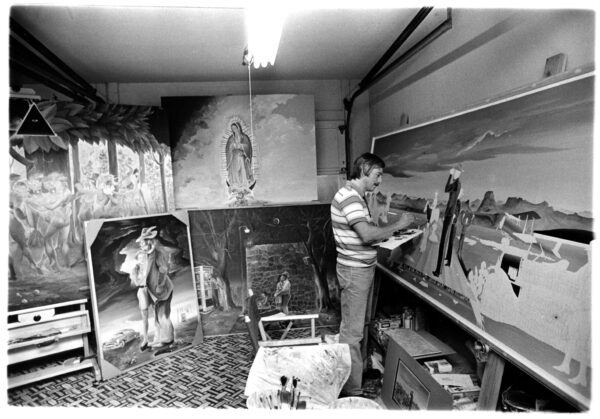
Roberto Ríos in his garage painting his “Marfa Sector” mural for U.S. Border Patrol Marfa Station, 1977. Photo: Texas State University.
Ríos was also the most commercially successful local Chicano artist, until a watercolor made in 1970 (more about that below) got him “blackballed” in the San Antonio art establishment. This article treats Ríos’ Chicano works from the 1970s, which I saw in San Marcos, with the exception of Chicano Gothic. Unless otherwise noted, the works were exhibited at the Texas State Galleries. I use the term Chicano broadly, to include not only works that feature references to the United Farm Workers, pre-Hispanic cultures, and racial mixing, but also works that treat daily life, folklore, and the U.S.-Mexico border.
Background and Training
Roberto Ríos was born on December 14, 1941 to Jesse Ríos and María Louisa Medina Ríos in San Antonio. He taught himself many aspects of painting, beginning in his final year of junior high school, after a helpful librarian showed him books on artists and art. Thereafter, he spent many weekends during the next four years at the San Antonio Public Library (see Virginia.edu blog).
In 1960, according to the Bullock Museum’s Texas Story Project, Ríos graduated from the San Antonio Vocational High School. That same year, he won second prize in an international poster contest that had 69,000 entries. Ríos worked for the City Public Service Company as a commercial artist, beginning in 1960. He also studied commercial art at the Warren Hunter Art School (Hunter was a famous watercolor and commercial artist) for six years, and, in 1970 and 1971, he also took some art classes at San Antonio College (Preston J. Robbins, “The Chicano Art Project,” April 13, 2019).
Ríos explains his self-identity this way: “I consider myself as American first, then Spaniard, then Mexican. And when the label Chicano came upon, I said, ‘well what the heck, let’s go ahead with that’” (audio recording made with the artist’s son Eduardo Ríos in response to questions I posed; further quotes from this source are marked with an asterisk).
Ríos had the honor of being the featured artist in the only color issue of the San Antonio-based publication called Magazín (“Pintura de Roberto Ríos,” January, 1973). In a statement quoted in Magazín, Ríos declared: “…to me the difference is in the poetry that makes the painting. It is the warmth that comes from applying your whole heart into the work” (quoted in my book Con Safo: The Chicano Art Group and the Politics of South Texas, UCLA: Chicano Studies Research Center, 2009, p. 27).
César Martínez, who worked on Magazín, recalls:
color was expensive in those days and a really big deal that involved color separations and other technical back-flips. On the other hand, it would have been a disservice to present Roberto’s work in black and white as usual. After some debate we decided to splurge because it was worth it (email to the author, March 6, 2023).
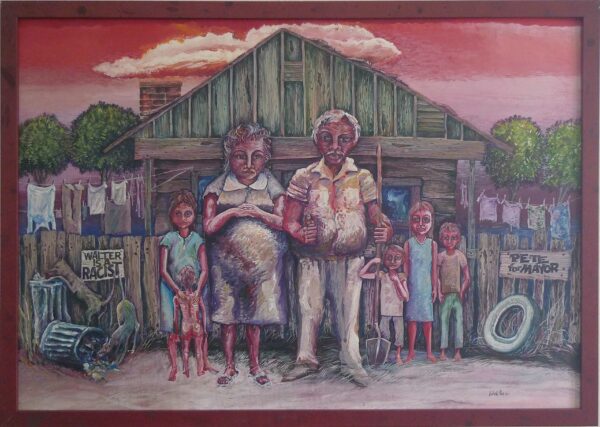
Roberto Ríos, “Chicano Gothic,” 1971, acrylic on illustration board, 28 x 40 inches, collection of Judge Tina Torres. Photo: Ruben C. Cordova. (In my book, I dated this painting 1970 based on information from the artist, but it is dated 1971 twice on the painting.)
Before venturing to San Marcos, I begin with Chicano Gothic (1971), which is an acrylic version of the watercolor that offended much of San Antonio’s art establishment. It depicts a bedraggled Chicano family inspired by Grant Wood’s American Gothic (1930). Wood depicts a hieratic, centrally posed farmer and his spinster daughter, modeled on his sister and dentist. They are dressed in outmoded fashions, but in what would have been their Sunday best. Their attire makes the pitchfork a discordant element — it seems as much a weapon as a farm implement.
Ríos’ couple and their children were conceived in a parodic, antithetical manner. While Wood’s subjects are slim, tight, pinched, and severe, Rios’ are rotund and expansive. Wood’s composition is vertical: the tines of his pitchfork are echoed in the seam of his bib overalls, and continued by the lines on his shirt. These lines are echoed in the vertical elements of the neo-Gothic house behind him. The landscape elements (note the severe trees in particular) are even more ordered and geometric than his human subjects.
Instead of a formally posed couple, Ríos paints a lively, more casual scene, though, compositionally, the central pair and the simple frame house in the background refer unmistakably to American Gothic, as does the title. Chicano Gothic expands horizontally. Clothes hang on lines on both sides of the house. Ríos’ trees humorously mimic those painted by Wood, though they are not quite as fanatically geometric.
The father Ríos depicts is relaxed. He holds a cold beer in his right hand. His wife is pregnant. Instead of a pitchfork, he has a shovel. Its highlighted structure echoes the trident form of Grant’s pitchfork, though it lacks the aggressive character of the latter. It is also grasped by one of his sons, which implies generational continuity. Five children surround this couple. The youngest child has no clothes, which evokes the embryo in utero.
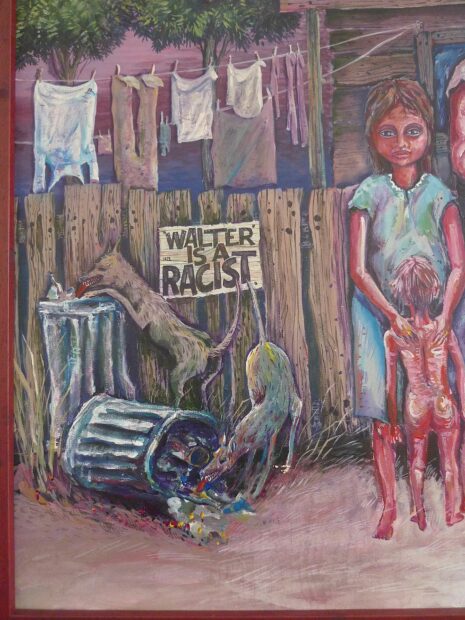
Roberto Ríos, “Chicano Gothic” (detail of left side) 1971, acrylic on illustration board, 28 x 40 inches, collection of Judge Tina Torres. Photo: Ruben C. Cordova.
On the left, dogs eat out of trash cans, one of which is overturned.
On the right, one can see a discarded whitewall tire. But what really gave offense was the sign above the dogs that read “Walter is a racist.” This refers to Walter McAllister, San Antonio mayor, banker, and head of the political machine known as the Good Government League (GGL).
Over the years, Chicanos found McAllister offensive for multiple reasons, and in 1970, a remark he made on the Huntley-Brinkley Report (televised July 6 and 7) sparked protests and a boycott of his bank. County Commissioner Albert Peña, Jr. called McAllister “a Nazi, a fascist, or both,” and he vowed to protest his “racism, even if we land in jail everyday” (see my book Con Safo, 2009, p. 15-19). Also see my Glasstire article “José Esquivel, Part 1,” for a related watercolor by Esquivel that also refers to the politics of the moment.
The “Pete for Mayor” sign above the whitewall tire is a reference to Pete Torres (1933-2007), a city council member who attempted to censure McAllister, and who challenged, but lost to the GGL mayoral candidate. Torres’s obituary notes his role in “causing the demise of the political machine known as the Good Government League.” Also see my Glasstire article “Felipe Reyes, Part 3” for more on the GGL.
Torres, who met Ríos while the latter was performing jury duty, was so touched by the message of Chicano Gothic that he bought it and kept it in his various law offices for the rest of his life. The painting is now in the collection of his daughter, Judge Tina Torres.
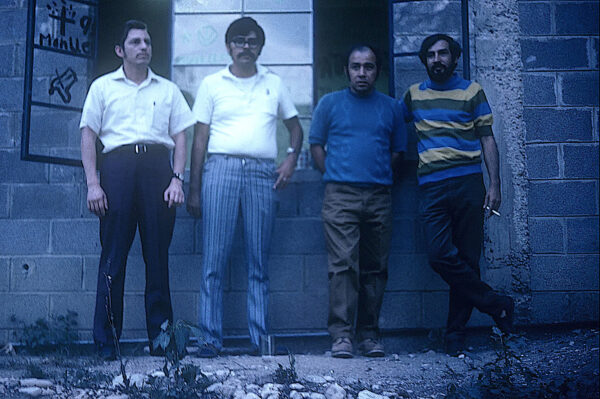
Roberto Ríos, Felipe Reyes, José Esquivel, and Jesse “Chista” Cantú, at La Universidad de los Barrios (an alternative school for Chicano youth on the West Side of San Antonio), probably October, 1970. Photo: José Esquivel website.
Ríos, one of the six co-founders of the Con Safo group, is pictured here with three of the other co-founders. Ríos was often disillusioned with the group for several reasons, as I note in my book, including internal bickering, power conflicts, some proposed associations with leftist political activity, and the loss of nine of his paintings during an exhibition in support of farm workers in Mission, Texas.
These paintings, along with works by other group members, were sold off for five dollars each without the artist’s authorization (Con Safo, 2009, p. 42). According to Ríos, a secretary at the organization kept two of his paintings.* A source tells me two now deceased professors in Edinburg bought a number of Rios’ works, and I hope their heirs will make some kind of settlement with the artist and bring these important, ill-gotten artworks into the public sphere.
In the audio guide for the Mind Windows exhibition, Ríos refers to the group as a “rip-off,” though he doesn’t say why. See the commentary called “Transcriptions of Roberto Rios’ Audio Guide Commentaries” in the Appendix at the bottom of the article, where his commentaries on the paintings in this article are all transcribed.
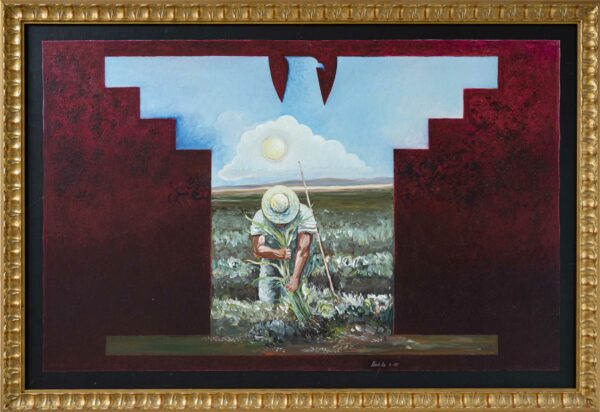
Roberto Ríos, “Bracero II,” 1972, acrylic on canvas, private collection. Photo: Madelynn Mesa. Exhibited at the Centro Cultural Hispano de San Marcos.
Bracero II is the earliest of the paintings exhibited at San Marcos. Its most remarkable element is that the scene it depicts is within a void inside of a stained mahogany field. The Belgian Surrealist René Magritte often utilized silhouettes of birds in this manner. For a few examples, see “Magritte and Birds.” The particular void in Bracero II has an important political message: it takes the form of the eagle that is the emblem of the United Farm Workers (UFW).
Since the UFW’s strikes, marches, and boycotts sparked the Chicano movement, the union’s emblem is synonymous with the movement itself. For the history of the eagle, see my Glasstire article “Felipe Reyes, Part 2: The United Farm Workers and UFW Imagery, c. 1970-72.”
In Bracero II, the farm worker is toiling in a field with his head bowed down. He focuses on a single stalk of corn. Everything else is a blur. In terms of Chicano heritage, corn is an emblematic food. It fueled the rise of Mesoamerican civilizations, and it has served as a staple for more than 2000 years.
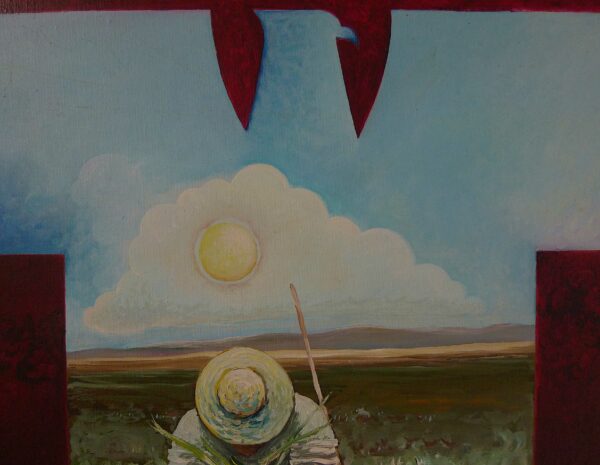
Roberto Ríos, “Bracero II” (detail), 1972, acrylic on canvas, private collection. Photo: Ruben C. Cordova. Exhibited at the Centro Cultural Hispano de San Marcos.
The circular forms of the worker’s hat rhyme visually with the sun that is above him, positing his labor as a source of life. This conceit was probably inspired by Vincent Van Gogh, who made similar allusions in his paintings.
As a child, Ríos performed migrant farm work in the summers with his family, so he has a first-hand understanding of the rigors of this form of labor.
In 1972, Ríos made a painting called Boycott that featured triple UFW eagle forms, including one fashioned out of a Magritte-like “negative space.” For the artist, this trebling reflected the Catholic Trinity. See Con Safo, 2009, p. 42-43.

Roberto Ríos, “Doña Lisa” (“Lady Lisa,” a pun on Mona Lisa), 1973, acrylic on canvas, courtesy of Christine Perez. Photo: Madelynn Mesa.
After parodying American Gothic, Ríos turned to the most-parodied panting of all time: the Mona Lisa (Leonardo da Vinci began it c. 1503, and he worked on it intermittently for many years).
Ríos’ variation on Leonardo’s Mona Lisa is set against an arched window. Her proportions are more Mannerist than Renaissance. Ríos makes numerous additional transformations.
Instead of the panoramic landscape background favored by Leonardo, Ríos’ woman is framed by a mostly black night sky, with the moon and a solitary planet. Doña Lisa proclaims her solidarity with the UFW through three eagles on the trim of her blouse. Her skin is brown (with traces of other colors), and its wrinkles almost suggest the furrowed earth.
The woman’s hair is fixed in a bun, perhaps to reveal her neck. Her head and neck are outlined in a fiery combination of red and yellow. On the right, one can see little points that recall the flames that surround the Virgin of Guadalupe (see the painting below this one for a depiction of Guadalupe). Ríos’ half-length woman is consequently a synthesis of the Mona Lisa and the Virgin of Guadalupe (the latter appealed to Mexican and Chicano audiences because of the darkness of her skin). César Martínez made a similar synthesis in his painting Mona Lupe: The Epitome of Chicano Art (the first of several versions was made in 1975).
Much has been written about Leonardo’s painting, though the strangest over-interpretation/projection is surely that of the Victorian writer Walter Pater, who viewed the Mona Lisa as an ancient vampiress: “She is older than the rocks among which she sits; like the vampire, she has been dead many times, and learned the secrets of the grave.” (For more of Pater’s strange analysis, some very beautiful reproductions, and yet another tendentious interpretation, see the BBC’s “The Detail that Unlocks the Mona Lisa.”) I won’t follow Pater down his stony vampiric path, but I will say that Ríos’ Doña Lupe looks very familiar with the earth, since her wrinkled skin recalls its furrows. Perhaps it is this agricultural association that makes her sympathetic to the UFW.

Roberto Ríos, “Doña Lisa” (detail with fly and UFW eagle), 1973, acrylic on canvas, courtesy of Christine Perez. Photo: Ruben C. Cordova
In the above detail, one can see that a fly is perched on the sitter’s shoulder. Since ancient times, painters have risen to the challenge of rendering such trompe l’oeil (deceive the eye) details, and Ríos takes his turn here. As a devout Catholic, he was also undoubtedly aware that flies have long served as symbols of sin and the devil in the Christian artistic tradition.
In the frieze of the cracked (and presumably ancient) window frame visible on the right, one can make out a UFW eagle, on which C/S is inscribed. C/S is the abbreviation for con safo, an idiomatic term that, at its most basic, means “don’t touch this.” The group took this term as its name. Mel Casas gave 22 (mostly ironic) definitions of con safo in his ironically titled “Brown Paper Report” of December 19, 1971 (reproduced in Con Safo, 2009, p. 63).
On the frieze, directly below the small UFW eagle with the C/S graffito, one unexpectedly encounters yet another fly. Furthermore, a snake is located beneath the fly on the frieze. Leonardo’s painting is regarded as the supreme embodiment of female mystery. By including these various emblems, Ríos adds a few mysterious wrinkles of his own.

Roberto Ríos, “Angustia de la Raza” (Anguish of the Race) 1974, acrylic on canvas, courtesy of the artist. Photo: Madelynn Mesa. Exhibited at the Centro Cultural Hispano de San Marcos.
A man stands on an island or cloud (or is it a cloud island?). He’s barefoot, his shirt is unbuttoned, and his hands are balled up in fists that are stuffed into the pockets of his baggy pants. They must be on fire because flames emanate from his wrists. His arms and part of his lower torso are burning or bursting into flames.
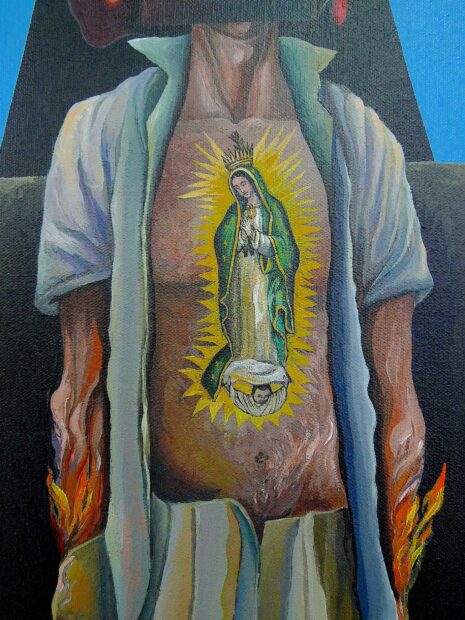
Roberto Ríos, “Angustia de la Raza” (Anguish of the Race; detail of torso) 1974, acrylic on canvas, courtesy of the artist. Photo: Ruben C. Cordova. Exhibited at the Centro Cultural Hispano de San Marcos.
A row of flames is visible behind him at the level of his knees. He stands in the foreground of a mauve rectangle with a keyhole-like void, the outline of which is lined by flames on the right and by a glowing outline on the left. The Virgin of Guadalupe, who appears on his chest, is likewise surrounded by flames, a tradition that stems from the Book of Revelation, which noted a woman “clothed with the sun.” (José Esquivel extended this fiery aura to a group of Chicanos in the foreground of his watercolor West of Town (1970). See “José Esquivel, Part 1.”)
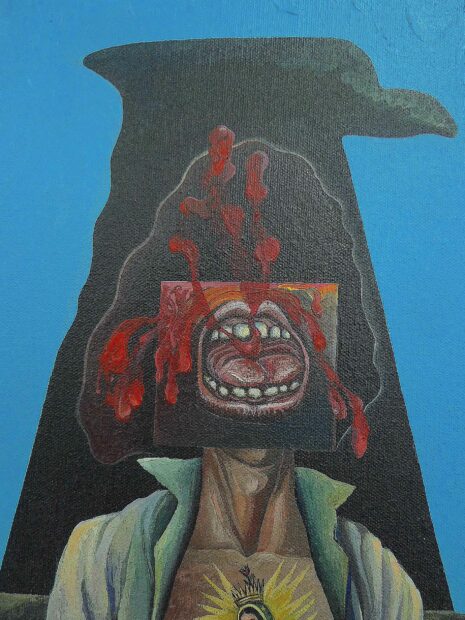
Roberto Ríos, “Angustia de la Raza” (Anguish of the Race; detail of head) 1974, acrylic on canvas, courtesy of the artist. Photo: Ruben C. Cordova. Exhibited at the Centro Cultural Hispano de San Marcos.
But all this fire in Angustia de la Raza pales in comparison to his screaming mouth — the only portion of his head that is visible. Like an erupting volcano, it emits thick-textured, lava-like blood.
Behind this man, one can see the silhouette of the upper portion of a black UFW eagle. As noted above, this eagle is synonymous with the Chicano movement.
At the top right, the keyhole void is broken, creating a silhouette that suggests a bird’s head and beak, thus doubling the avian form of the UFW eagle (and again referencing Magritte).
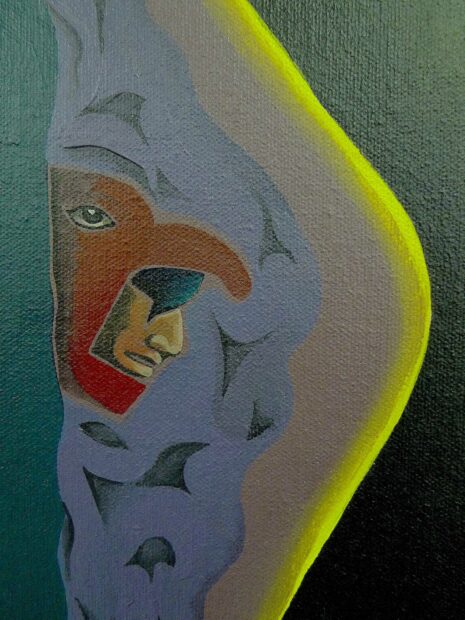
Roberto Ríos, “Angustia de la Raza” (Anguish of the Race; detail of Eagle Warrior) 1970, acrylic on canvas, private collection. Photo: Ruben C. Cordova
In the center of the left side of the rectangular area, one can make out the head of an Aztec Eagle Warrior, which is encased within an eagle mask.
The implication is that while the contemporary Chicano is Christianized, he carries the legacy of the Aztecs with him, and the eagle — now in the form of the UFW eagle — remains his emblem in his struggle for equality. His bi-national and bi-racial nature is underscored by the ribbons of color that are just above his ankles. The red and white colors are common to the U.S. and Mexican flags. The lowest colored band is green on the left and blue on the right, a synthesis of the national colors of the two flags. The fire that rises just above these colored bands suggests that any synthesis of these different traditions is taking place in a crucible of fire.
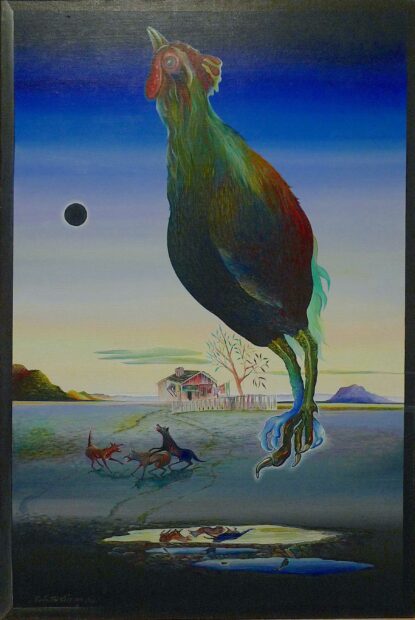
Roberto Ríos, “Gallo Dormido” (Sleeping Rooster), 1975, acrylic on canvas, courtesy of the artist. Photo: Ruben C. Cordova
Gallo Dormido is based on a Mexican folk tale that tells of a sleeping rooster that misses his opportunity to crow in the morning. For Ríos, the sleeping rooster that floats in surrealistic fashion in the center of the picture is the epitome of lost opportunities. This painting is an allegory of opportunities taken and opportunities lost.
According to Ríos’ audio commentary, the solar eclipse (seen on the left of the suspended rooster) “points to a missed opportunity of light on the earth.” For Ríos, the rutting dogs are “like when people screw one another for opportunities to advance.” Similarly, the house in the background represents the opportunity for advancement: “The old house where I lived is a symbol that where I lived is not where I will end.” Given their clear resemblance, Ríos’s childhood home and its rickety fence must have served as the models for those structures in Chicano Gothic (and note the absence of geometrically manicured trees in the background).
In his audio commentary, Ríos continues:
I am between three countries: America, Spain, and Mexico. I am poor, but not as poor as one living in the poorest countries, or in the streets of America. I have lived with economic oppression, but I lived with faith. After it rains, there are water puddles on the street that represent repeated missed opportunities.

Roberto Ríos, “Gallo Dormido” (Sleeping Rooster; detail of lower section of painting), 1975, acrylic on canvas, courtesy of the artist. Photo: Ruben C. Cordova
In Gallo Dormido, Ríos paints three water puddles. The first one reflects most of the three dogs. The second one shows the tail of one dog and the head of another. The third reflects the eclipse and most of the floating rooster, though the latter is easy to mistake for the rooster’s largest talon.
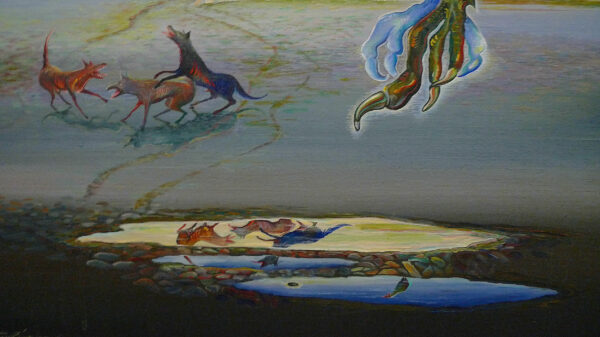
Roberto Ríos, “Gallo Dormido” (Sleeping Rooster; detail of water puddles), 1975, acrylic on canvas, courtesy of the artist. Photo: Ruben C. Cordova.
Gallo Dormido provided the artist with the opportunity to display his fluency as a handler of paint. Ríos particularly likes to render foreshortened reflections in puddles of water, as he does in Gallo Dormido. In this work, he is most deeply influenced by Salvador Dalí’s technique.
Like Dalí, Ríos paints impossible scenes with compelling precision. There is no reason that a sleeping rooster would float in the air in this manner. The scene’s preternatural, uncanny clarity calls attention to the painting’s fundamental strangeness. The house is bizarrely dislocated from the barrio it inhabited (stylistically, the house shares characteristics with buildings in early paintings by Joan Miró). The bleakness and emptiness of the painting contribute to its intensity. Ultimately, Ríos is depicting a proverb that he elaborates with highly personal symbols. The dogs, the house, and the eclipse have uniquely personal meanings within his mental universe. The puddles reflect — and thus multiply — these lost opportunities.
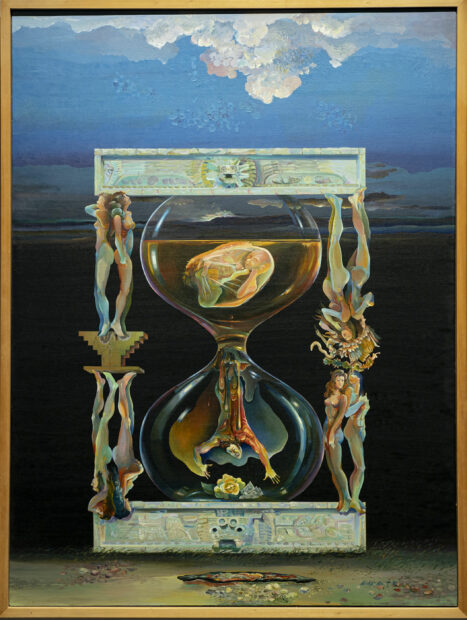
Roberto Ríos, “Tiempo y Vida” (Time and Life), 1976, acrylic on canvas, courtesy of the artist. Photo: Madelynn Mesa.
Tiempo y Vida is one of Ríos’ strangest and most fascinating paintings. It uses the hourglass — one of the oldest memento mori devices — as an emblem of time/life. Instead of grains of sand, a solitary man passes through the hourglass.
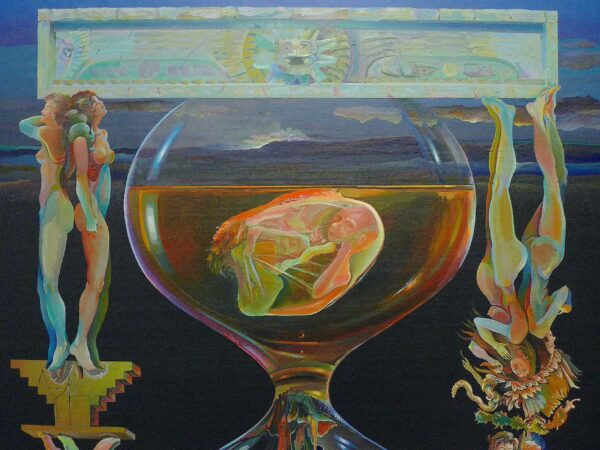
Roberto Ríos, “Tiempo y Vida” (Time and Life; detail of top portion of hourglass), 1976, acrylic on canvas, courtesy of the artist. Photo: Ruben C. Cordova.
From the above detail, we can see that the hourglass is framed by elements taken from the Temple of the Plumed Serpent at Teotihuacan. (See the reconstructed model in the Anthropology Museum in Mexico City.)
The head of the plumed serpent god (Quetzalcoatl) is visible in the center. In the audio guide, Ríos refers to it as the Aztec god of the harvest, which is no doubt why he places a small Eagle Warrior (similar to the one in Angustia de la Raza) in the leftmost section.
We can also see shells, which are emblems of fertility. Four pairs of female caryatid figures complete the hourglass’s framework. The UFW eagle and the Mexican eagle on a cactus are meant to join the caryatid figures.
In the top half of the hourglass, a rather adult-looking embryo floats in fluid. One woman in each of the four pairs is pregnant. Ríos explains that this is a commentary on women marrying young in Mexican and Mexican American culture, as young as fourteen or sixteen years of age.
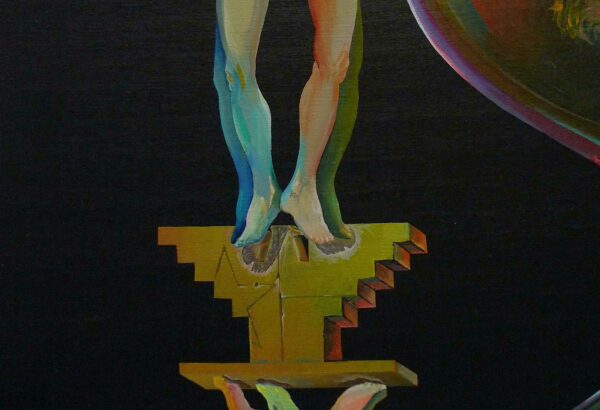
Roberto Ríos, “Tiempo y Vida” (Time and Life; detail of UFW eagle on the left side of the hourglass), 1976, acrylic on canvas, courtesy of the artist. Photo: Ruben C. Cordova.
The golden-brown UFW eagle, here presented as a Chicano emblem, looks like it is made out of stone. One can see that a star is etched into the side of it, which stands for Texas. Thus it is specifically a Tejano Chicano emblem. But the strangest aspect of this work is the fact that the feet of the women to not actually rest firmly on the eagle. Consequently, they cannot really serve as an effective framework for the hourglass. They instead float nearby, close enough to cast shadows. They mimic and intimate a framework without actually constituting one. The dangling legs impart a dream-like strangeness to the painting.
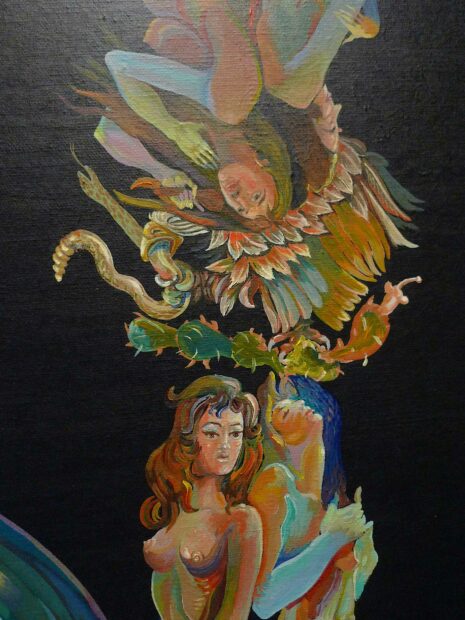
Roberto Ríos, “Tiempo y Vida” (Time and Life; detail of Mexican eagle on the right side of the hourglass), 1976, acrylic on canvas, courtesy of the artist. Photo: Ruben C. Cordova.
On the right side, the women are inverted. Their heads are at the center of the hourglass, rather than their feet. They do not connect with the Mexican eagle, either. The eagle seems to be behind them. Of course, if the women beneath the Mexican eagle standard were connected to it, their heads would be pressed against the prickly pear cactus on which the eagle perches.
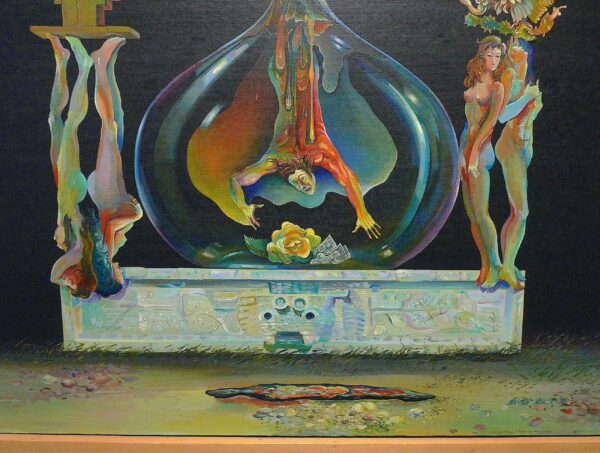
Roberto Ríos, “Tiempo y Vida” (Time and Life; detail of bottom portion of hourglass), 1976, acrylic on canvas, courtesy of the artist. Photo: Ruben C. Cordova.
Another portion of the Teotihuacan Temple of the Plumed Serpent serves as the bottom of the hourglass. In the center, one can see the Teotihuacan version of the goggle-eyed rain god, generically known as Tlaloc. The rain god, the shells, and the nubile women are emblems of fertility and regeneration.
The embryo at the top of the hourglass represents life, the product of fertility. In the bottom portion of the hourglass, that embryo is seemingly birthed as an adult male, who bursts downward, reaching for money and a yellow rose. The latter could potentially represent happiness and fulfillment, for which money is necessary.
Whereas Ríos depicted an Eagle Warrior in the top left portion of the upper stone frame of the hourglass, on the right side of the lower register he depicts the head of an old man, one who is well past his prime. Tiempo y Vida is a very strange allegory of time and life, for it seems that as soon as you are born, time is running out, and you are plunged into the bottom of the hourglass.
A puddle beneath the hourglass reflects it, but in an illegible fashion. It is as if time and life are so fleeting that they cannot readily be fixed and captured in a reflection, unlike the dogs, the eclipse, and the rooster in Gallo Dormido.
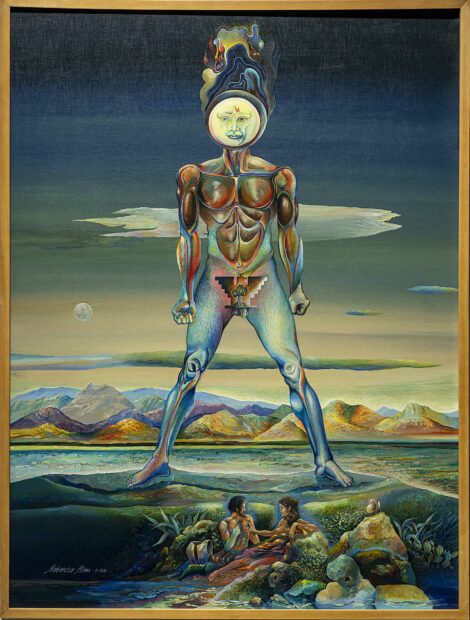
Roberto Ríos, “Mestizo” (Mixed Race), 1976, acrylic on canvas, courtesy of the artist. Photo: Madelynn Mesa.
The figure in Ríos’ Mestizo straddles the landscape like a mighty god. With its sharply stylized forms and bright, arbitrary color, it reminds me of some of the monumental figures painted by the Mexican Muralist José Clemente Orozco.
The figure’s bi-national nature is represented by its head, which is a sun, and the UFW eagle that seems to have alighted on his genitals. The Aztecs called themselves “the people of the sun,” and the UFW eagle, as noted above, is the paramount Chicano symbol.
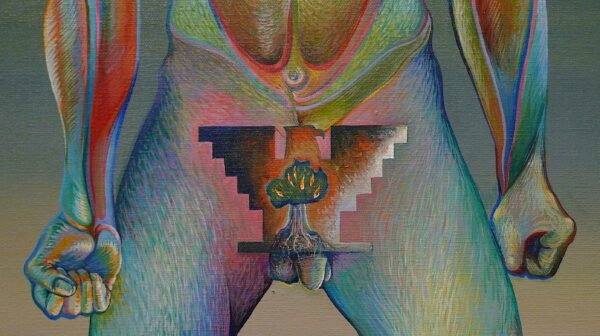
Roberto Ríos, “Mestizo” (detail of lower torso), 1976, acrylic on canvas, courtesy of the artist. Photo: Ruben C. Cordova.
A flaming tree superimposed over the eagle symbolizes the family tree and the biological continuity of the mixed race.
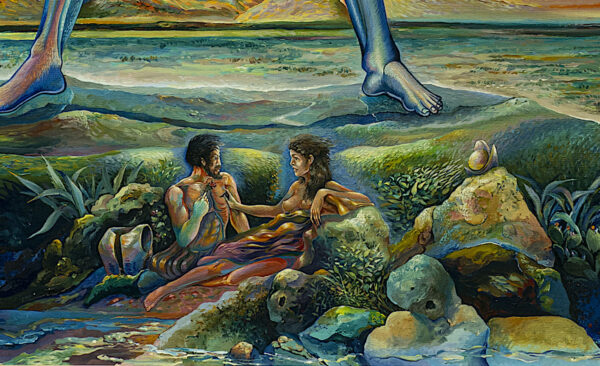
Roberto Ríos, “Mestizo” (detail of figures and landscape at bottom), 1976, acrylic on canvas, courtesy of the artist. Photo: Madelynn Mesa.
Racial and cultural mixing are depicted at the bottom of the painting, where the Spanish conquest is presented as a love story, akin to Adam and Even in a new Paradise. A Conquistador has shed his armor (though he still has his boots on), and he is offering a rose to a partially naked (presumably) indigenous woman, as if to say that all he wants to conquer now is her heart. The woman, who has curly hair, does not look indigenous. In fact, she closely resembles one of the seated women in Día de Pago, which is illustrated and discussed below.
The woman reaches out to accept the red flower. Her dress is red, white, and green, the Mexican national colors, signifying that their coupling will produce the first mestizos. She, of course, already looks like a mestizo.
The soldier’s steel helmet and breastplate serve as his emblems. Her emblems are anthropomorphic rocks. Above the breastplate, one can see the head of an eagle. Another eagle’s head (with a very large nostril hole) is beneath the woman’s body. The woman rests her arm on a rock that suggests a face of a jaguar. To her right, the bluish rock suggests another avian creature. Below the helmet, one can see another nascent head, perhaps of another eagle. Even the yellowish rock in the lower right corner of this detail resembles a fish, with its mouth on the extreme right. Ríos invites the viewer to tease out even more anthropomorphic forms.
The eagle, a supreme Aztec symbol, is an important part of the landscape. This woman’s progeny will utilize the UFW eagle, one whose “stepped wings” refer to an inverted Mesoamerican stepped pyramid.
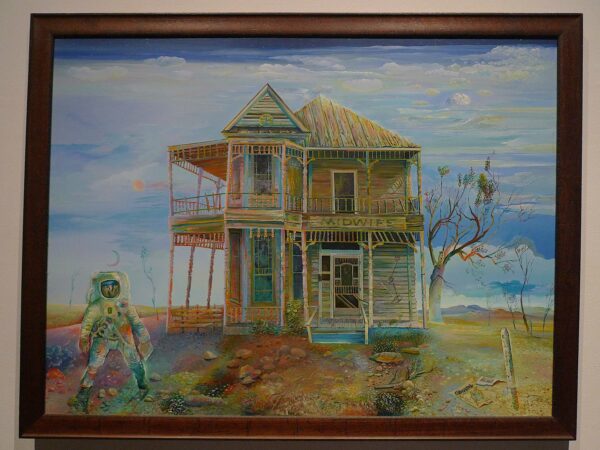
Roberto Ríos, “Midwife,” 1976, acrylic on canvas, courtesy of Eduardo and Moneta Ríos. Photo: Ruben C. Cordova.
Midwife is one of Ríos’ most beautiful and enigmatic paintings.
An old, solitary building bears the sign “Midwife,” hearkening back to traditional practices in the age of space travel. The latter is symbolized by an astronaut with a crescent moon overhead.
As Ríos notes, “the building was an actual building in San Antonio that was eventually torn down.”* It was “known throughout the West Side as the home of a very significant midwife.”* This painting was based on a reference photograph taken by the artist (illustrated below).
Ríos recalls that the buildings on either side of the midwife building were demolished, and for a time it stood alone, though it was not as isolated as it is in the painting.*
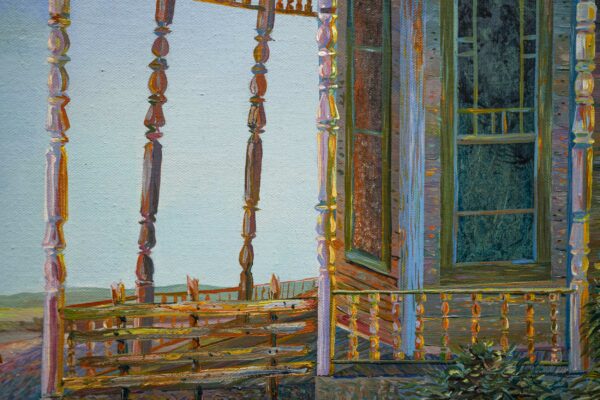
Roberto Ríos, “Midwife” (detail of building), 1976, acrylic on canvas, courtesy of Eduardo and Moneta Ríos. Photo: Madelynn Mesa.
The warped building is probably abandoned, and it is surely haunted, since ghostly figures appear at the windows. For the artist, the layers of clouds in the background “represent time and space.”*
Ríos has also depicted a rather anthropomorphic tree. The artist explains its significance: “Going from the sky to the landscape representing the earth. The tree is the symbol of life and connects the sky and earth. We stand tall and connect the earth and the heavens.”*
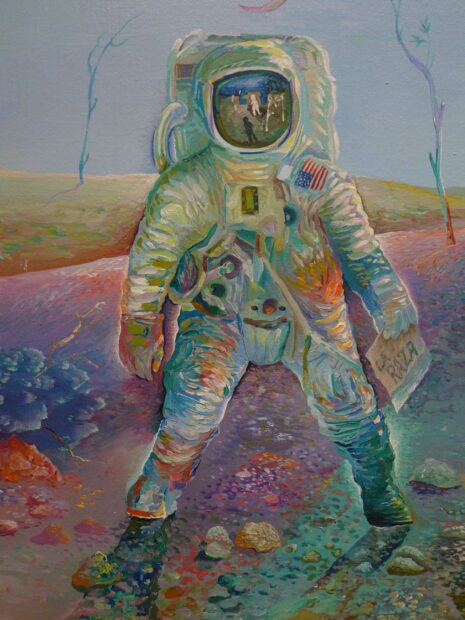
Roberto Ríos, “Midwife” (detail of astronaut), 1976, acrylic on canvas, courtesy of Eduardo and Moneta Ríos. Photo: Ruben C. Cordova.
The astronaut has a red-tinged suit, but that is reflected color, not blood (so the astronaut has not been delivering children). Ríos’ point is that “midwives have been around for a long time. They will be around no matter how we advance. Midwives are here to stay.”*
While the old house is gone, the knowledge that once inhabited it remains, and this wisdom and experience has been transmitted to space age practitioners. Ríos holds that if people ever settle on Mars, midwives will accompany them.* Above all else, what a newborn really needs is human warmth and touch (note that Ríos emphasized warmth in his statement in Magazín that is quoted above).
The most advanced scientific learning and materials have not superseded traditional healing and birthing practices. Moreover, as the artist explains, the clouds “show that midwives may even exist in some representation throughout time.”*
The astronaut holds a sign that is wrapped in plastic like an artifact. It reads “LA RAZA.” This refers to the ongoing preservation of Chicano culture, which embraced midwifery practices, as well as other healing traditions developed by the ancestors of contemporary Chicanos.
On the other side of the painting, near a bus stop, papers lie on the ground. One is Caracol, a Chicano magazine co-founded by César Martínez. The midwife building is a solitary ruin. It stands in isolation, with only traces of the lived community that formerly surrounded the building. The building was destroyed, and the Chicano publications likewise came to an end. But the knowledge they contained has persevered and continues to be transmitted to new generations.
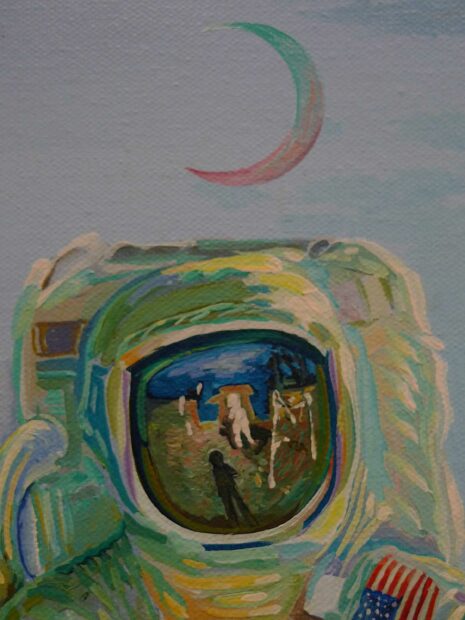
Roberto Ríos, “Midwife” (detail of astronaut’s helmet), 1976, acrylic on canvas, courtesy of Eduardo and Moneta Ríos. Photo: Ruben C. Cordova.
The astronaut’s facemask reflects what could almost be a scene from a bygone, mythic era, but it is in fact a rendering of Neil Armstrong’s 1969 wide-angle photograph of Buzz Aldrin on the moon. See Associated Press, “Here’s a Fact: We Went to the Moon in 1969,” WTTW News, July 15, 2019.
In 2021, artist Michael Ranger photoshopped the image to take out the distortions. See Michael Zhang, “Unwrapping Buzz Aldrin’s Visor in Moon Photo Reveals What He Saw,” PetaPixel, July 26, 2021.
The first moon landing and Ríos’ photograph of the midwife building are almost contemporary. Their juxtaposition symbolizes Ríos’ faith that the institution of midwifery will always exist.
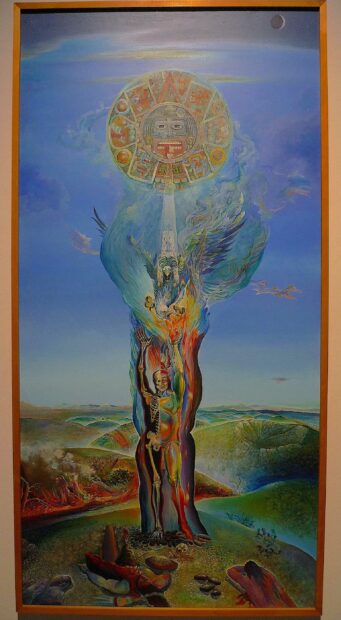
Roberto Ríos, “Quinto Sol” (Fifth Sun), 1977, acrylic on canvas, courtesy of the artist. Photo: Ruben C. Cordova.
Quinto Sol is Ríos’ depiction of a particular kind of sacrifice: the annual sacrifice of the impersonator of the god Tezcatlipoca. God impersonators, who played an important role in Aztec rituals, were not merely actors or pretenders in a limited sense. They served as embodiments and representatives of a god. See “Ixiptla—Deity Impersonator” in Mexicolore.
The Tezcatlipoca impersonator, a model of physical perfection, was chosen from the ranks of military captives (he was not, as Ríos says in the audio guide, an Aztec Eagle warrior). The impersonator was elaborately groomed and fêted for a full year — and then he was sacrificed with great pageantry.
The Aztecs referred to themselves as the People of the Sun, and they believed human sacrifice was necessary to sustain the sun. Ríos depicts the central portion of the Aztec Stone of the Sun (he refers to it as the Aztec Calendar, which is how it was commonly referred to in the past, though it is not technically a calendar). One can see (around the face) the Aztec glyph ollin (movement), which is how the Aztecs believed the current cyclic age (the fifth age, hence Ríos’ title) would end: through earthquakes.
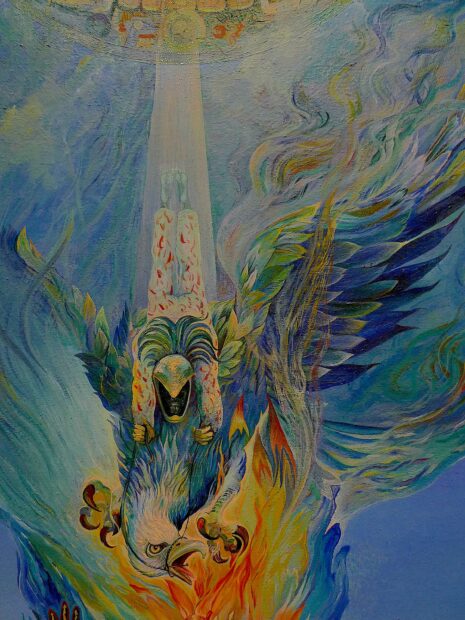
Roberto Ríos, “Quinto Sol” (Fifth Sun; detail of Eagle warrior), 1977, acrylic on canvas, courtesy of the artist. Photo: Ruben C. Cordova.
Ríos depicts a white-clad Eagle Warrior descending from the Stone of the Sun on a bald eagle.
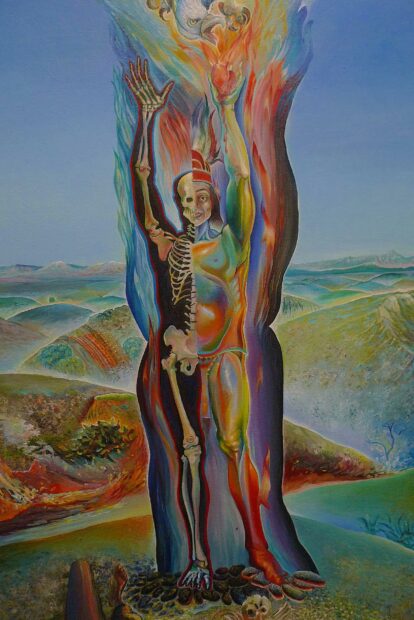
Roberto Ríos, “Quinto Sol” (Fifth Sun; detail of half skeletal figure), 1977, acrylic on canvas, courtesy of the artist. Photo: Ruben C. Cordova.
This warrior’s destination is his own sacrifice. The half-fleshed man wears the diadem of the Aztec ruler, as he holds a flaming sacrificial heart aloft.
Mesoamericans believed that life and death were interrelated, which is why they created images that were half flesh and half bone. Human sacrifice was part of this conception: it was necessary to fuel the sun and to repay the gods for the sacrifices they had made for humans.
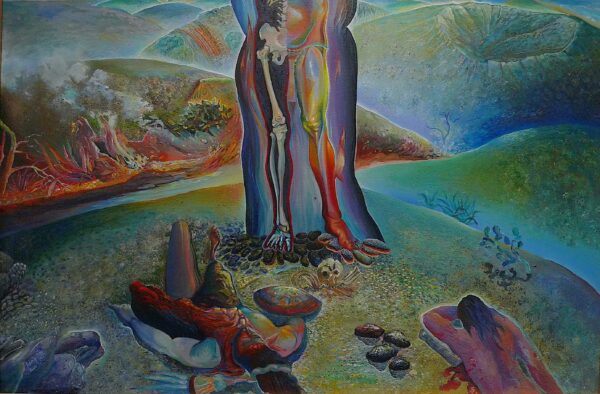
Roberto Ríos, “Quinto Sol” (Fifth Sun; detail of lower section of painting), 1977, acrylic on canvas, courtesy of the artist. Photo: Ruben C. Cordova.
The bodies in the lower section of the canvas represent Aztec sacrificial victims. In the audio guide, Ríos makes a connection between the violence inherent in Aztec religion and the destruction of the environment:
These people were carnivorous, they were barbarics. In the background you see what takes place, they would ravish the place. There was earthquakes, there was volcanic eruptions and so on.
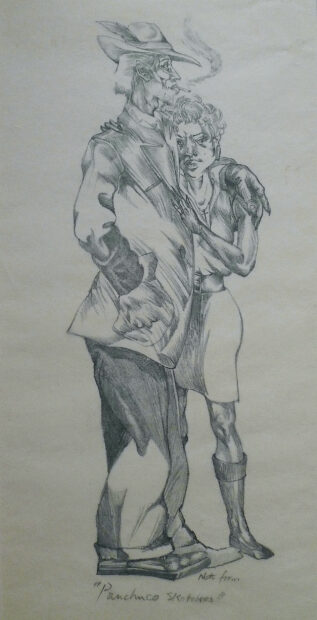
Roberto Ríos, “Study for the Amantes,” 1977, pencil on tracing paper, courtesy of the artist. Photo: Ruben C. Cordova.
Ríos’ remarkable draftsmanship is evident in this pencil drawing. I wish there had been other examples of this kind of drawing in the exhibitions (there were some early drawings at the Centro Cultural Hispano de San Marcos and some drawings for murals at the Texas State gallery).

Roberto Ríos, “Los Amantes” (The Lovers), 1977, acrylic on canvas, courtesy of the artist. Photo: Madelynn Mesa.
Los Amantes is part of Ríos’ Pachuco series. It features a centrally posed couple framed by colorful clouds. The clouds’ contours on the left echo the man’s hat and head. A small head appears in the clouds on the right. These strange features serve as surreal elements, as does the relative barrenness of the scene. Throughout his oeuvre, Ríos shows a predilection for rendering isolated objects.
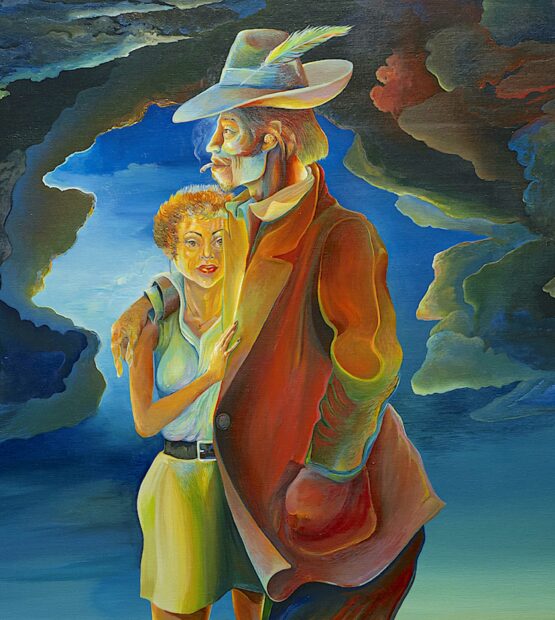
Roberto Ríos, “Los Amantes” (The Lovers; detail of couple), 1977, acrylic on canvas, courtesy of the artist. Photo: Madelynn Mesa.
This detail shows Ríos’ wonderful use of color, particularly in the fields of the man’s face and jacket, which are broken up into many islands and gullies of bright colors.
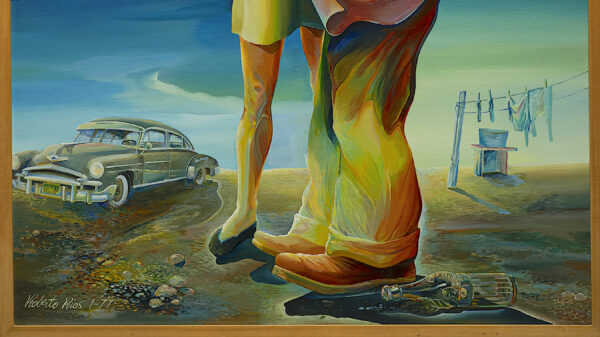
Roberto Ríos, “Los Amantes” (The Lovers; detail of lower section), 1977, acrylic on canvas, courtesy of the artist. Photo: Madelynn Mesa.
Apart from the couple, there is nothing but a lowrider on the left, an empty coke bottle underfoot, and clothes on a line (with a washtub on a shelf) on the right. This somewhat bizarre combination of small-scale elements accentuates the couple, endowing the two figures with even more monumentality.
At the same time, these objects serve to “defamiliarize” the scene. Where is this supposed to be? A humble laundry post in the middle of nowhere? Rather than pointing to a particular location, the car and the laundry perhaps serve as signifiers of gender roles. The man has his cool car, and, in order to ride in it, the woman has to do his laundry.

Roberto Ríos, “Día de Pago” (Payday), 1977, acrylic on canvas, courtesy of the artist. Photo: Ruben C. Cordova.
In Día de Pago, Ríos depicts what he calls a “ripple in time.” He describes the scenario at length in the audio guide. On payday, Ríos’ mother would send him to look for his father at a bar, where he would be drinking with his friends. His father would buy him a Coke and Fritos, and send him outside, telling him: “just a little longer.”
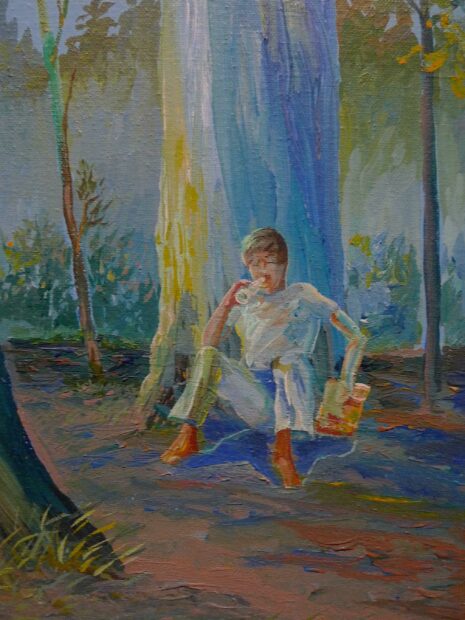
Roberto Ríos, “Día de Pago” (Payday; detail of Ríos as a child), 1977, acrylic on canvas, courtesy of the artist. Photo: Ruben C. Cordova.
In this detail, Ríos is drinking his Coke, eating his Fritos, and observing the scene, which he pictured in his mind as a work of art.
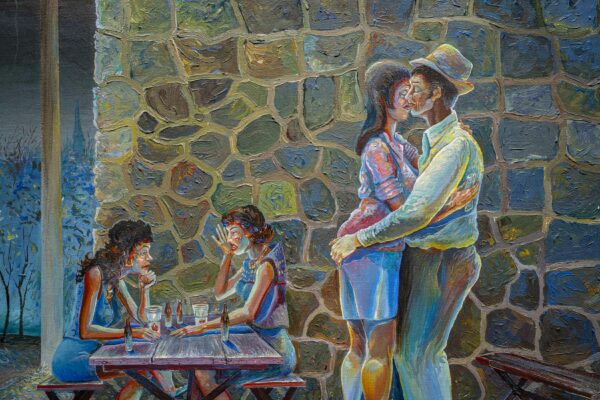
Roberto Ríos, “Día de Pago” (Payday; center detail), 1977, acrylic on canvas, courtesy of the artist. Photo: Madelynn Mesa.
Ríos recalls the “mysterious lighting” and the external speaker, as well as the “vandalized phone booth.” In this arena, the furtive couples “exchanged beer kisses, and slow dancing moves.”

Roberto Ríos, “Día de Pago” (Payday; detail of phone booth), 1977, acrylic on canvas, courtesy of the artist. Photo: Madelynn Mesa.
When a “guilt-filled man” was calling his wife, another man informed him: “Hey, these girls are waiting.” Ríos went inside and castigated the beer drinkers, and he and his father were sent home by the bartender.
Finally, as Ríos notes in the audio guide commentary on this painting: “When I was young, good and bad days become long for me. I used to hope time would move faster. Now I want to slow down time….”
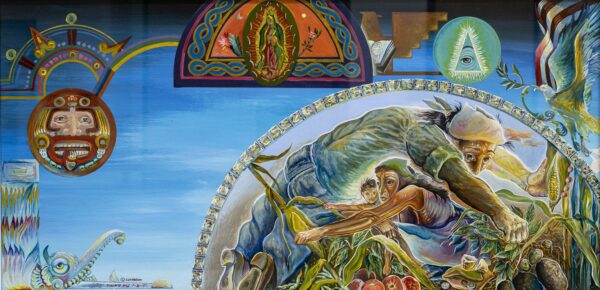
Roberto Ríos, “Rendering for Workers of the Land,” Heritage Village mural in Miami, FL, 1977, acrylic on illustration board, courtesy of the artist. Photo: Madelynn Mesa.
This is a study for a large mural Ríos painted in Miami in a neighborhood with many migrant farm workers, called the Naranja (orange) Project. This work pays homage to Mexican workers. A feathered serpent and a deconstructed Aztec Stone of the Sun on the left symbolize indigenous origins. The Virgin of Guadalupe presides over the center, followed by a UFW eagle and the all-seeing eye featured on a dollar bill. Finally, a bald eagle and a U.S. flag complete the immigration cycle.
In the lower right, a man, a woman, and a child perform farm work under a circular form that references the Stone of the Sun. The stone circle also symbolizes the stone enclosures in which the workers were housed, which Ríos likens to prisons in the audio guide. Their harvest consists of crops developed in the Americas, including corn, potatoes, and tomatoes.
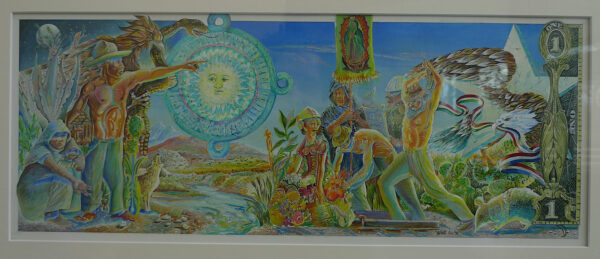
Roberto Ríos, “Mi sueño de oportunidad y esperanza es en el Norte,” (My dream for opportunity and hope is in the North),
color proposal for the Marfa Station mural, 1978, acrylic on illustration board, courtesy of the artist. Photo: Ruben C. Cordova.
Configured like a one dollar bill (with elements from a vintage dollar bill on the right), Ríos portrays two groups of Mexicans. Those on the left of the sun and the river are seeking to emigrate to find employment, while those on the right are working on the railroad, doing construction, and harvesting crops. A Mexican and a U.S. eagle inhabit their respective sides of the painting. A coyote howls on the Mexican side, while an armadillo on the U.S. side sniffs the ground. Armadillos did not cross the river on their own — they were brought to the present-day U.S. by humans.
This mural proposal was rejected. Ríos was told that it would encourage unauthorized immigration.
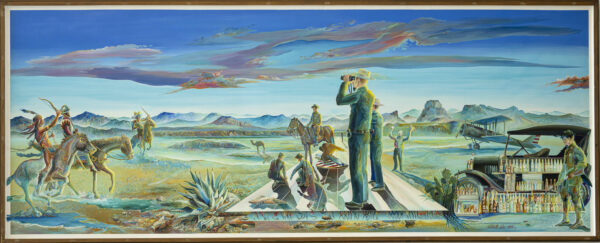
Roberto Ríos, “Marfa Sector” mural, 1979, acrylic on birchwood, Loan from the Fine Arts Collection, U.S. General Services Administration, commissioned through the Art in Architecture Program. Photo: Madelynn Mesa.
As noted above, Ríos’ Mi sueño de oportunidad y esperanza es en el Norte, his first proposed mural for this site, was rejected. His Marfa Sector mural, which won approval, is vastly different in style and subject matter.
His figures are relatively stiff, and rendered in a more conventional manner than the ones we have seen in earlier works. Yet there are still surreal elements. Most of the Border Patrol agents stand on an immaculate wood panel floor that magically floats above the desert. In enigmatic fashion, a bald eagle has alighted on a U.S. shield located on the wood floor.
Even more strangely, there appear to be several fantastic birds in the sky, fashioned out of clouds. The easiest to read is in the upper right. To its left, there appears to be a tiny silhouette of a man blowing a trumpet.
Except for the Border Patrol agents, the landscape is devoid of humans, except for three mounted, phantasmatic border crossers from a bygone age: a Spanish Conquistador, a Native American, and a Mexican Revolutionary.
The solitary camel refers to the U.S. Army’s experimental use of camels, which began in 1855 and ended during the Civil War, when most of them were captured by rebels and abused. Some camels, however, were released and wandered the border region for years. See Vince Hawkins, “The U.S. Army’s ‘Camel Corps’ Experiment,” ArmyHistory.org.
If the border agents are guarding anything, it would appear to be their remarkable stash of alcoholic beverages (presumably contraband) in the lower right of the painting. Thus Ríos’ painting strikes me as satiric in ways that, had they been recognized, this mural also might have been rejected.
Conclusion
I had high expectations for the body of work covered in this review, and Ríos’ paintings did not disappoint.
In my book on the group, I noted: “For Ríos, group activity served to characterize and confirm the work he was already doing: ‘You’re walking, you know you’re walking, and then somebody puts a name on it’” (Con Safo, 2009, p. 6). Given this quote, I’d hoped to see some Chicano paintings prior to or at the very beginning of the group’s formation in mid-1968. Though Bracero II was dated 1968 in the promotional materials I received and on the label at the Centro Cultural Hispano de San Marcos, it is signed and dated 1972.
I included Chicano Gothic (1971) in this article due to its historical importance and early date. In his piece on Ríos for the Bullock Museum, Robbins says: “One of the paintings of the Chicano Movement started with Chicano Gothic….” I’m not entirely certain what Robbins is trying to say, but he does seem to be giving chronological priority to Chicano Gothic (overall, I do not think his article is reliable).
Ríos noted that he made drawings of braceros his senior year in high school (1960), which served as the basis for his work on Chicano themes.* At the present time, however, I am unable to document Chicano paintings made by Ríos prior to 1970.
Ríos quit the Con Safo group on November 5, 1973 when other members engaged in a heated conflict (see Con Safo, 2009, p. 45-46). His last Chicano activity was participation in the 1978 ¡Dale Gas! exhibition at the Contemporary Arts Museum Houston.* (For information about this show, see “José Esquivel, Part 1“). Thereafter, Ríos painted the murals discussed above and he subsequently explored spiritual themes in his art.
In terms of purely formal painting qualities, Bracero II (1972) is the most modest of the paintings in this review, though I appreciate the cleverness and the clarity of its composition. Angustia de la Raza (1974) is arguably the most powerful painting from an iconographic perspective.
For sheer handling of paint, Ríos’ Chicano works from 1975 to 1977 are the strongest among those on view at San Marcos (though this sample is too small to make any sweeping generalizations).
Gallo Dormido (1975) is as strong as any of the later surrealist-style paintings in the various exhibitions in San Marcos. Tiempo y Vida (1975) is as original as it is strange. I appreciate the monumentality and the unusual coloristic effects of Mestizo (1976). Midwife (1976) is exquisitely painted, with a startling rendering of the smallest details, such as pebbles on the ground, as well as the clouds and the general atmosphere. Quinto Sol (1977) is Ríos’ dynamic and searing critique of Aztec religion — human sacrifice in particular. The painting Amantes (1977), along with the pencil study for it, are the sole representatives of Ríos’ famed Pachuco series. I had hoped to see more examples of this series, but Amantes may well be the best of them. Día de Pago (1977) is another very strong, deeply personal work, and the artist’s narrative in the audio guide provides many insights into the painting.
All in all, the works treated in this article are quite strong. While Ríos’ other works on view in San Marcos were mixed in quality, his Chicano subjects were consistently good. For sheer handling of paint, I think Midwife and Amantes were the best works in the various exhibitions. I am very glad to have had this extremely rare opportunity to see Ríos’ paintings in San Marcos.
***
Appendix
Below, see transcriptions of Roberto Rios’ Audio Guide Commentaries.
Angustia de la Raza 1, 1974
This painting is part of my political activist artwork during Con Safo art group, from 1968, group early meetings, 1977. [Ríos left the group in November of 1973] At that meeting, one member brought his friends into the meeting without letting anyone know. He proclaimed that he was a Communist and said it is time to put down our art brushes and pick up arms. I stood up and said: “You are stupid. I would be fired. It would take away my family’s security. After that I stood up and said: “Enough!” I am tired of the arguing and the lack of work on the part of the group. I walked out of the meeting in Mario’s Restaurant November 5, 1971. I spoke with Jesse Almazán at the reborn gallery, before he died. He was still angry about Con Safo. I told him that group was facing a certain death of greed and power by certain individuals. At that time, I worked at Brooke Medical Center in San Antonio, Texas. To me, the Con Safo art group was a rip-off.
Angustia de la Raza 2, 1974
At this period, I was painting art to help César Chávez, la Huelga. We used the symbol, or I used the symbol of the eagle in part or full. Here I have it in the center behind this figure. The sky is blue and there is one cloud. And it rushes with fire. It describes the feeling of the time. Con lumbre, con fuego, with fire. With this force of flames. This center figure is one that is poor, that struggles. He is oppressed. His head is a solid scream. Scream so loud that even blood is spilled out with that force. That force of angustia, of anger inside of him. Just pouring out in a scream. His chest is covered with the tattoo of the Virgen de Guadalupe, which was used a lot of times by the huelga. The Virgen de Guadalupe was used in many things during that time. His arms are full of flame. You know, it’s just like making a fist and there’s flames coming out of your arms, and he is barefooted because he is oppressed and struggling. Struggling, and yet, he is not really being like everybody else. He is like a form of protest. A protest to the public, to the politics of the day. And he is standing in a cloud alone.
Gallo Dormido (Sleeping Rooster), 1975
The rooster that sleeps will miss an opportunity. There is a Mexican folktale that I heard as a child. It says: Si se te duerme gallo, it is a series that I am working on of cuentos. This particular thought speaks directly to everyone because when you miss an opportunity, you are like the sleeping rooster in my story. But when you become aware of this moment, it’s lost. The feeling it’s a questionable moment and it comes with a lesson. The answers come in how you react and move on. Everything is in the state of emotionless mind. I paint this artwork to symbolize that this cuento story can even happen to all people. Rich or poor, whenever a missed opportunity occurs. In my painting, there is an eclipse that points to a missed opportunity of light on the earth. Two other symbols are the dogs, that is like when people screw one another for opportunities to advance. The old house where I lived is a symbol that where I lived is not where I will end. I am between three countries: America, Spain, and Mexico. I am poor, but not as poor as one living in the poorest countries, or in the streets of America. I have lived with economic oppression, but I lived with faith. After it rains, there are water puddles on the street that represent repeated missed opportunities.
Tiempo y Vida (Time and Life), 1975
I painted this painting to kind of feel the time of life, like it’s in a hourglass, from the embryonic stage onto life in the struggle for survival. Of money, you know to survive, so we are constantly struggling to survive. That covers all that we do in life. On top of this things that frames the hourglass is the god of the harvest, in the Aztec history. And below that is another god. This god is called the rain god. To bring the rain so that the harvest will flourish, to feed the people. So these two are very important for survival. And on the sides I speak about the young girls, getting married at an early age of fourteen, sixteen. It was known that a lot of young maidens were getting married early, in many times, you know, in the history of the Mexican people and the Mexican Americans. So the symbol of Mexico and the eagle and the symbol of Chicano is on the other side. So it is all about tiempo y vida, and the reflection of it in a little pool of water after the rain. The rain god is there.
El Quinto Sol (The Fifth Sun), 1977
I was always inspired by stories of the indigenous, of the Aztecs, and their kingdoms. Their stories evolved through sacrifice, through pain, through struggles, through growth, through all the things they did in details of how they believe life should be. And in this painting, El Quinto Sol is the center of the Aztec calendar, it has different squares, which would be the four ways that the earth ended: water, fire, and storms. In the center is the face of the god, that’s everything. It’s powerful. It’s the sun with a big grin. And from it, I show a shooting light. And the shooting light is on the Eagle Warrior. This is the person that is chosen to be sacrificed. For a whole year they celebrated him. They gave him everything he wanted for the whole year. They dressed him up in like white with feathers of eagles and stuff like that. So he was the eagle warrior. And he flies through the whole year, he walks in that year with everything, with the mentality that he is sacrificing his life for the people. For what? For anything that, you know, any kind of protection. This is what it symbolizes: protection. And he rides in, as the eagle brings him. And it shows right there this skeletal, half-skeletal, half-man, which is the priest that brings—on the ground there’s captives—warriors that were captured. After a war they bring the bodies. Some are completely alive, of course. And they put them on this rock at the top of the temple, where there are many stairs going up. And they put him there. And the priest gets this sacrificial knife, and he plunges it right here, in the seventh rib (?), and he opens up the body and takes out—cuts out the heart while still beating–and he offers it to the high zenith, when the sun is way up on top. And the heart is still kind of like still beating, because it’s just plucked out. And he offers it to the sun. They cut the head off, they roll it down, and the rest of the body is taken away and divided in parts and given to the people. These people were carnivous, they were barbarics. In the background you see what takes place, they would ravish the place. There was earthquakes, there was volcanic eruptions and so on. That was Mexico at that time. You know, when all this civilization was expanding and, you know, the fifth sun is when they believed that it ended. But, as we know, they are still around.
Día de Pago (Payday), 1977
Payday. My art is about my youth, when I looked to the future with hope, to things that are not yet here, and in my young old age [when Ríos made the painting], I am looking back at the memories that are gone, and a part of me in the past.
When I was young, good and bad days become long for me. I used to hope time would move faster. Now I want to slow down time, walking with everyone else in struggles and surprises that surrounded in my life. Everyone I knew had their share of the same.
I painted this painting of a ripple in time, which conveys a thought and feeling as being sent to find my father, and get him home on a payday night. I remember the loud nostalgic musical polka, and conjunto sounds blaring from a speaker. I was thirteen years old when my mother would ask me to go and find my father at different bars, not far from home.
When I found him, I asked him in front of his beer-drinking money-wasting camaradas (companions) that it was time to go home. He would answer, “just a little longer,” and he would buy me a coke and a small bag of Fritos. My dad would say: “go out in the back and eat these Fritos out in the back.” As I waited, I grew very impatient and finished my coke and Fritos. The conjunto music was loud from the speaker attached to a tree. I’ve always liked to study people and this was a good place to do that. It looked to me, in a sense, the men seemed to be drinking away their guilt. Our Southern expression: “No guilt, no pain, no cares.”
They were my behavior experiment. Three men came out from the bar with three women, to sit out on the wooden tables. They began to drink, and dance outside. They felt so safe, for no one was watching in Escondido Street. They exchanged beer kisses, and slow dancing moves. It was like a coiled snake, hidden in the light of a waxing crescent moon and a tempting summer breeze, with a cold beer. It made things pretty. I saw the entire surrounding as an image in my mind made for a work of art, with mysterious lighting, and a vandalized phone booth, with broken glass by the street sign. I renamed the street, a perfect for the setting: Escondido, Hidden Street. One guilt-filled man went to call his wife to inform her that he would be home soon. I heard their conversations. The other man was calling him back. He told him: “Hey, these girls are waiting.” Just then, I went back inside.
I stood by my father and yelled aloud: “Why do you people make the bar-owner richer by spending your hard-earned weekly money on beer? You don’t make much money and you waste it instead of buying food and paying your bills. Then the bar owner told my father and I to go home. He didn’t like what I was saying. I painted that memory to create awareness that everyone who is a fool who wastes hard-earned money by giving their money to bar owners.
Rendering for Workers of the Land, Heritage Village, 1977
This is a mural project that I got through the National Endowment and the state of Florida. They put me in the governor’s list because I was chosen, and I had to present my idea, my renderings before a cross-section of the people of Florida and the mayor and dignitaries, you know, the [Mexican] counsel and so on, in Dade County, Florida, South Miami. And I was there with artists like Troval, Baskin, you know, quite a few people that I read in books. That was, and I said, “what am I doing here? Oh god.”
So anyway, my turn was to present, and I showed the rendering, and they passed it around, and some people kept it too long, and then it came to me, and I explained it. And this is what I put in it. The project was for a sector in the farm workers area of South Miami. It’s called the Naranja [orange] Project. The architect and the guy in charge of the migrants were so jumping with joy when I came into town. They set me up in a beautiful Spaniard home with thick walls like the Alamo that they bought and were remodeling. And they were selling it. I lived there for a little while. And then the city gave me a room on the Duval [Hotel] twenty-third floor to stay. But the drive on [Highway] 195 all the way to the Everglades, you know, close to the Everglades, where Homestead, past, to the Omica Housing Corporation. I said: “It’s too much, the traffic and everything. So I’ll just put two desks together here and I’ll set up, you know,” I said, “I want a canvas.” And “no, we don’t have a big canvases,” the town said. “We have to wait, it will take a couple of months to get it here.” “No, I want something now. Well, can you get birch wood and just make 18 by whatever it was, 6 by 18, something like that, and put it on wood with holes with wooden pegs that will lock-in in place where I want it there. There is nothing but pegs that will hold it together. And then protect it somehow, you know, because it will be outside.” Then they said, “Well, OK, let me build a wall.” So they built the wall.
And I spent my time painting from, I guess, 7 o’clock in the morning until about 3 AM [PM?] and then drive across to Perrine, across the tracks to a little place to eat something. I think they had cube steaks and water, and that’s what I ate and I came back. One time I came back and there was police all over the place. It turns out that they had Haitians at that time coming in Miami, and they were on the roof. And they were living up there. So they brought ‘em down and were against the wall, and I was trying to open– I went and parked right in front and the police were right there. I opened the door and I put my keys to try and open the door and the policeman grabbed me and put me in the wall. I said: “Wait. I gotta go in there, I am working in there.” He said: “Shhhh. Shaddup, shaddup, shaddup.” “O.K.”
And then, finally after they talked to everybody, put them in cars, then they said: “now who are you?” I said, “I’m an artist from San Antonio, if you want to hear….” “No.”
“It’s in here, a card, that’s Merick Clark. He knows me. Call him and he’ll vouch for me. He’ll tell me—he’ll tell you who I am. I’m painting a mural in here.”
“Well let’s see your mural.” I opened it up and I took him to the back room where I had locks on all the doors. And I opened up, and he said: “Oh, that’s pretty good. O.K. Well, sorry.” So they left.
So, anyway, this, in this painting I put, ‘cause the project was in Naranja, and it was for farm workers, and what they did, they built, the architect, Ted Hoffmann designed dwellings for seven families. It was just like a box, long and there were, you know, a big area in the center where they could eat and talk and so on. And seeming like captive warm, you know farm workers, here. “No, it’s for their benefit, it’s going to help them to have housing, they can be ready for the fields.” Captives. Farm workers. “O.K., so what’s the name of it?” “I don’t know.” “Well, what kind of people are going to be here?” “Well, there’s Mexicans, there’s Cubans, there’s Africans.” “Why don’t you call it Heritage Village?” “Yeah, that’s it.” So it stuck.
In Heritage Village I just put symbols of Mexican, you know, things, because the guy, the chief, was from Mexico. So he insisted: “Put Mexico there.” O.K., so I put symbols of, you know, Quinto Sol and so on. But at the top, I put the Virgin and I put the Chicano [UFW] eagle with a book open and then with an olive branch connected to the circle of the almighty dollar symbol, the eye, and then it connects to the American flag and then goes down into the actual brick thing, around like, they have them in prison. In other words, they have them captive, and here they are, struggling in the fields, in the corn fields, and they have tomatoes, potatoes, stuff, symbols everywhere. How much were they getting? 27 cents a little box or bag. So I put that in there, too. So it’s a family. A father and the mother and child, and they are all working in the fields.
Mi Sueño de oportunidad y esperanza se en el Norte, 1979
This is a rendering, full color rendering of a mural commissioned by the National Endowment. After the exhibit [¡Dale Gas!] at the Contemporary Arts Museum [Houston, 1977] I was picked by the Endowment to do a mural commission in Marfa, Texas, that has symbols of how the struggles of the Mexican migrants. What they go through. They have symbols of the moon and the eagle behind old lady extended her hand to beg, and the old man with his craft of arts, which was a little bird cage that he brings. And he is pointing his opportunities and hopes are in the North, he is saying with that gesture. And behind it, you see the eagle with the snake, the symbol of Mexico. And it kind of touches the symbol of El Sol, which was one of the symbols of Mexico. The sun. And below it are the mountains, you know, represent the Southwest, the entrance into Texas from Mexico. The Rio Grande. I have a wolf, I mean a coyote, howling. When they saw that they said: “That cannot be here. It will encourage more illegals to come, and it will just bring a lot of people from Mexico.
I have another drawing, a color rendering that I brought with me. And it’s entitled Marfa Sector, and its all about your history of this area, and what you keep surveillance. You keep watch that no contraband, no drugs, nothing, crosses the border into the United States. And sometimes you wonder, is it closing the freedom of those that are trying to find it in America. It closes everything for them. ‘Cause it’s their hopes and dreams to come and work in America.
***
Ruben C. Cordova is an art historian and a curator who has curated more than 30 exhibitions, including ten solo shows by Con Safo group members. He has written or contributed to 19 catalogs and books. His book Con Safo: The Chicano Art Group and the Politics of South Texas (UCLA: Chicano Studies Research Center, 2009) was the first to be written on a Chicano art group.


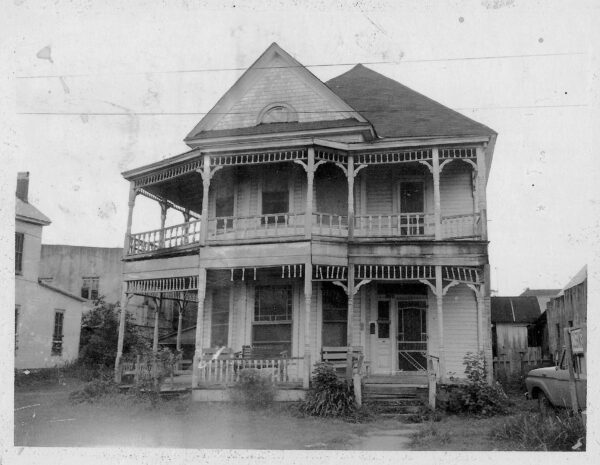

2 comments
Thank you to Ruben Cordova for a strong comprehensive reading of the expansive paintings and exhibitions in San Marcos venues of this great early Chicano painter. Roberto Rios is one of the great metaphorical chicano artists whose work spoke of resistance and a cultural reintegration for Chicanos when it was a very new concept. Rios painted of embodiment using ancestral and cultural iconography as a path forward. The quality of his painting expression was at the highest of levels and with a demanding seriousness. These six exhibitions celebrated a lifetime of a search for finding a path forward for all Chicanos. I came to Con/Safo too late and missed knowing him but I saw his work at the Dale Gas Exhibit in Houston and felt very inspired. He is a great painter.
You are very welcome, Roberto. I’m glad I got the chance to see these exhibitions and to write about them. Ríos is a great painter with a wide range of interests, as well as one of the foundational Chicano artists. Almost a quarter of a century after I began researching his work, it was a thrill and a pleasure to finally see so many of his paintings in person.